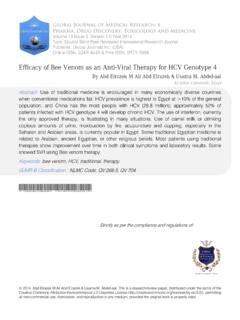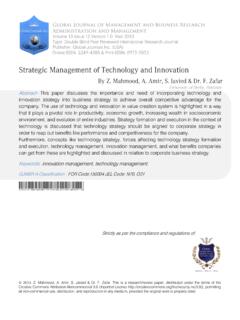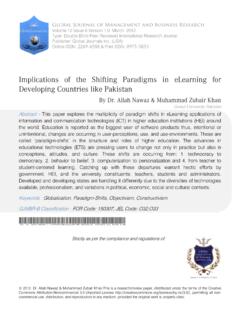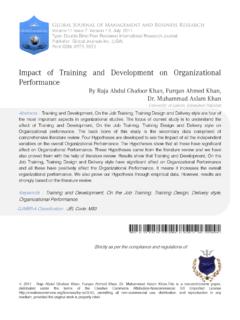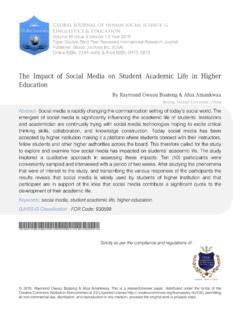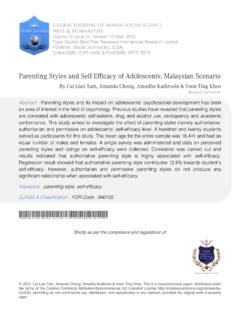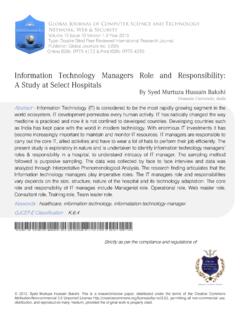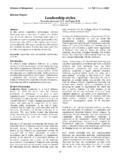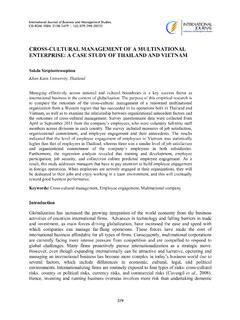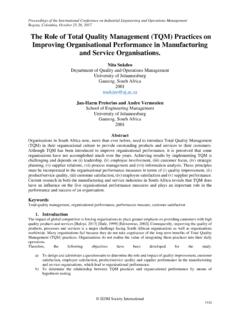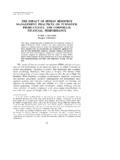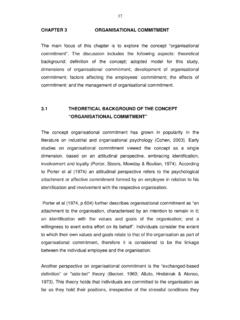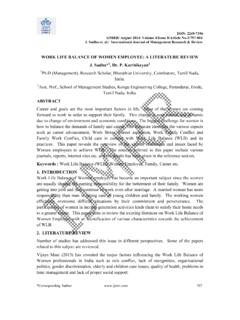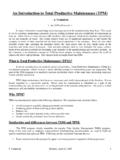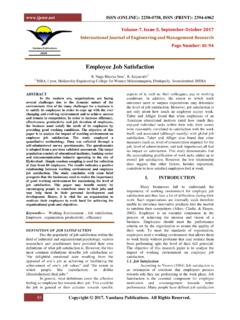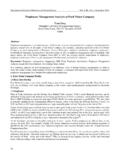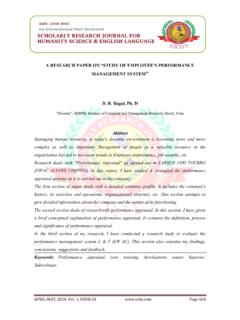Transcription of Employee Empowerment – An Empirical Study
1 2017. Mr. P. Jaya Kumar & Prof. Dr. A. Ananda Kumar. This is a research/review paper, distributed under the terms of the Creative Commons Attribution-Noncommercial Unported License ), permitting all non-commercial use, distribution, and reproduction in any medium, provided the original work is properly cited. Employee Empowerment An Empirical Study By Mr. P. Jaya Kumar & Prof. Dr. A. Ananda Kumar Rajiv Gandhi Arts and Science College Puducherry Abstract- Employee Empowerment is giving a certain degree of Employee s autonomy and responsibility for taking decision regarding their specific organizational goals. The main purpose of this Study is to determining the effect of Employee Empowerment strategy which is implemented by organization. Being descriptive research Study , survey method was adopted for data collection to find out the factors. The researcher used this research design is to find out the fact of respondents attitude and opinion about Employee Empowerment .
2 The methodology comprised research design, Target population for the Study , sampling techniques, sampling Method, sample size determination etc. Data was analyzed by using Cronbach s Alpha, Simple percentage method, Chi-square method, ANOVA method and Correlation method in SPSS software. The Study analyzed the effects of various strategies adopted by the management for Employee Empowerment . Keywords: Employee Empowerment , organization, satisfaction , strategy. GJMBR-A Classification: JEL Code: M51 EmployeeEmpowermentAnEmpiricalStudy Strictly as per the compliance and regulations of: Global Journal of Management and Business Research: AAdministration and ManagementVolume 17 Issue 4 Version Year2017 Type: Double Blind Peer Reviewed International Research JournalPublisher: Global Journals Inc. (USA)Online ISSN: 2249-4588& Pr int ISSN: 0975-5853 Employee Empowerment An Empirical StudyMr.
3 P. Jaya Kumar & Prof. Dr. A. Ananda Kumar Abstract- Employee Empowerment is giving a certain degree of Employee s autonomy and responsibility for taking decision regarding their specific organizational goals. The main purpose of this Study is to determining the effect of Employee Empowerment strategy which is implemented by organization. Being descriptive research Study , survey method was adopted for data collection to find out the factors. The researcher used this research design is to find out the fact of respondents attitude and opinion about Employee Empowerment . The methodology comprised research design, Target population for the Study , sampling techniques, sampling Method, sample size determination etc. Data was analyzed by using Cronbach s Alpha, Simple percentage method, Chi-square method, ANOVA method and Correlation method in SPSS software. The Study analyzed the effects of various strategies adopted by the management for Employee Empowerment .
4 The Study explains that Employee Empowerment is a kind of motivational strategy which gives the employees a sense of satisfaction towards their job and organization. Keywords: Employee Empowerment , organization, satisfaction , strategy. I. Introduction he organization believes in enriching people s jobs and giving authority to exercise control over and take responsibility for outcomes of efforts. In 21st century the industrial organizations are more concerned about knowledge workers because they are the real drivers of business. An empowering organization emphasizes on autonomy, proper information and individual participation for organizational excellence. In order to achieve Empowerment , the executives must ensure that employees having the right mix of information, knowledge, power and rewards to work more enthusiastically. However, from a long-term perspective, rising incomes, improved affordability and untapped markets present promising opportunities for automobile manufactures in India.
5 Empowerment thus helps to create autonomy for employees, allows the sharing of responsibility and power at all levels, builds Employee self-esteem and energizes the work force for better performance. At the individual level the personal factors which are facilitating Empowerment are: challenging jobs, enthusiasm, competence, maturity, self-esteem, etc. most of these factors can be enhanced through training and develop- Author : Assistant Professor, Department of Business Administration Rajiv Gandhi Arts and Science College Puducherry, India. e- mail: Author : Professor & Head, Department of Management Studies, Christ College of Engineering & Technology, Puducherry 605010, India. e- mail: ment as these are playing a catalytic role in promoting Employee Empowerment and involvement. A new way of management is Employee Empowerment or participative management involving the people responsible for the work processes-the people who know the processes best is where quality starts.
6 Some think that employees work only for financial return. If they are incapable to be an integral part of the organization, this may be true. Allowing employees to have independence and feedback within the organization is what makes the Empowerment process successful. When employees are empowered, their confidence degree and self-reliance will increase. This extra confidence is a good thing because it creates job satisfaction and high levels of productivity. However, in some cases, confidence levels can be taken too far and end up crossing the line into arrogance. Arrogant employees are difficult to deal with, don't take direction well and can become insubordinate. Working in this type of work environment takes its toll on employees and they once again become dissatisfied with their job and productivity levels decrease. The research is to find out the Empowerment of employees who is working in Manatec Electronics Pvt.
7 Ltd., which is located in Union Territory of Puducherry State. The Study is obviously to understand the level of freedom given to the employees to do their jobs in effective manner. Finally, the research is used the various statistical tools to measure the level of satisfaction of employees at research area. II. Literature Review Klagge J. (1998) sees the literature in a way indicating the meaning of Empowerment as to release improved power and authority along with the relevant duties and expertise to employees. Empowerment seems to be a powerful management tool, which is used to exchange the shared vision that the organization expects to materialize into common goals. The reality is that Empowerment could be utilized as an expression to explain diverse plans providing an expedient oratory, advocating that Empowerment is hypothetically a fine object that fabricates a, win-win condition for workers and administrators (Raquib A.)
8 2010). Empowerment has been defined in numerous ways, but most authors agree that the core element of Empowerment involves giving employees a discretion (or latitude) over certain task related activities. Randolph (1995) defines Employee Empowerment as a transfer of power from the employer to the employees. Blanchard T 2017 Global Journals Inc. (US)59 Global Journal of Management and Business Research Volume XVII Issue IV Version IYear ( )A2017et al. (1996) for instance argued that Empowerment is not only having the freedom to act, but also having higher degree of responsibility and accountability. This indicates that management must empower their employees so that they can be motivated, committed, satisfied and assist the organization in achieving its objectives. Ideas to various social reform movements in the 1960 and 1970 social reform movements such as the civil rights movement, feminism, and others.
9 Potterfield (1999) indicates that through personal conversation with management and Employee Empowerment experts, he found that these experts were uncertain about when and where the term was used in management and organizational studies. Recently, Thomas and Velthouse (1990) advocated seeking alternative perspectives on Empowerment that distinguish between situational attributes ( management practices) and job incumbent cognition about those attributes ( psychological Empowerment ). Similarly, Conger and Kanungo (1988) argue that management practices are only one set of conditions and that those practices may empower employees but will not necessarily do so. Employees can be empowered psychologically through supporting mechanisms such as those that build competencies, motivation, and knowledge sharing, placing employees in control of their work-place destiny (Sprietzer 1996).
10 Ozaralli (2003), Where there is commitment to make change, Employee Empowerment becomes a function of transformational leadership. Under such a leadership perspective there is a sense of mission, pride, faith, respect, excitement and commitment . Transformational leaders will exist at all levels of the organisation, coaching staff, providing formative learning, and delegating responsibility through assigning projects that contain appropriate learning experiences. They will encourage innovative approaches to work and a critical reasoning approach to decision-making. Transformational leaders create a dynamic organizational vision that often necessitates a metamorphosis in cultural values to reflect greater innovation. We can also propose that transformational behaviors on the part of leaders promote empowering cultural norms (Ozaralli 2003).


